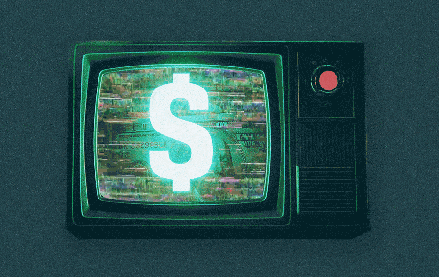
This Future of TV Briefing covers the latest in streaming and TV for Digiday+ members and is distributed over email every Wednesday at 10 a.m. ET. More from the series →
This week’s Future of TV Briefing looks at the topics and trends likely to set the tone for this year’s upfront negotiations.
- The upfront ahead
- Upfront Week: Day 1
- YouTube’s NFL exclusive, the creator economy’s studio system and more
The upfront ahead
Trigger warning for those affected by the 2020-21 upfront cycle. And the 2021-22 cycle. And the 2022-23 one. OK, maybe this year’s upfront — which formally kicked off with this week’s presentations in New York City — will be less aberration and more return to the recent norm.
How the annual TV and streaming ad haggle will actually go is anyone’s guess. But based on conversations with executives at agencies, TV networks and streaming services, the following are among the topics most likely to dictate the marketplace. And let it be said that Trump’s tariffs and the corresponding economic downturn are the ultimate factors at play, but we all know that so what more is there to say? Well, everything else.
Deal pace
Actually, the tariffs could play a more nuanced part in this year’s upfront negotiations. The 90-day pause is set to expire on July 8, which recently has been right around when major TV network owners had announced the close of their upfront negotiations. And sure, just this week Trump announced a separate 90-day pause on the 145% tariff on imports from China, but that still leaves a 30% tariff on those imports.
The topsy-turvy tariff situation could push TV and streaming sellers to try to secure ad dollars before any further economic nosedive that could scare away advertisers. Or it could give brands and agencies cause to pause to see how exactly their businesses may be affected before making multi-million-dollar commitments.
The latter prolonged upfront scenario wouldn’t necessarily be so bad for sellers if it could avoid a recurrence of the 2022-23 upfront in which advertisers and agencies committed early but then pulled back budgets in late summer when it was time to put pen to paper and place their orders.
Sports marketplace
Historically sports has been an upfront marketplace almost entirely unto itself. That’s unlikely to be the case this year. Live sports inventory is in such demand among advertisers that it’s as recession-proof as any aspect to the upfront.
The TV networks and streaming services know this. That’s why they pay billions of dollars for sports rights in the first place, and it’s why agency executives expect sellers to require ad buyers accept their non-sports inventory in order to access the sports supply.
There is another option, though. The sellers could speed-run a sports-centric upfront cycle with sky-high pricing and surrender the rest of the upfront to being a buyer’s market, though there would seem to be less upside with that angle.
Cancelation options
And now we arrive at what may be the main sticking point in this year’s negotiations: How committed will advertisers need to be to the year-long deals they sign this summer?
In the past, the answer was very. No cancelation options for the fourth quarter, and then a sliding scale from there that still kept the majority of ad dollars secure in sellers’ coffers and required 6 to 8 weeks’ heads up to cancel any spend ahead of a quarter.
But the cancelation options have become more lax since the pandemic, and ad buyers plan to flex them further this year. Some TV network executives said they have already had advertisers float the potential to cancel 100% of a commitment 30 days ahead of a quarter’s start. And some agency executives said they would like streaming sellers in particular to adopt the Interactive Advertising Bureau’s industry-standard cancelation option for digital deals, which allows advertisers to pull out 100% by 14 days before a deal is set to take effect.
There seems to be little sell-side interest in the latter flexibility option (shocker, I know). Roku had previously offered advertisers a two-day cancelation option on their upfront deals, but asked if that remains the case for this year, all that a Roku spokesperson would say is that Roku “offers flexibility in cancellation clauses for our advertisers.”
Popularity of principle-based buying
One way advertisers can secure greater flexibility in their upfront commitments is by not being the ones to actually commit in the upfront. Agency-level upfront deals have become more commonplace in recent years, and the rise of principle-based buying – in which agencies buy inventory from platforms and publishers and effectively resell it to their clients – sets up for an upfront in which the principal buyers could be the agencies.
But there’s a but. Some advertisers may prefer to be the ones on the hook for their upfront commitments, not their agencies. They may be wary of their agencies marking up the resold inventory to pad their profits. Or they may not want to surrender the legacy pricing they enjoy from having participated in the upfront for years, if not decades.
The upfront’s middle class crunch
As covered in this newsletter a couple weeks ago, mid-sized advertisers may be among the more decisive factors in this year’s upfront. These advertisers are newer to the upfront and, as a result, have been subject to more aggressive price increases compared to the legacy upfront advertisers. If they’re asked to accept increased rates this year, they may balk.
On a similar note, mid-sized TV network owners and streaming services may struggle to secure upfront commitments to the scale they may have enjoyed in the past. As mentioned above, the upfront sellers peddling sports should be fine enough, but there are plenty of cable TV networks and even more streaming services that lack rights to the major sports leagues and may find a lack of demand for the programming and audiences they do have.
Both camps could come out of this year’s upfront market with a different perspective on the upfront’s primacy to their ad dealings. The buyers could bet on their abilities to secure traditional TV impressions in an already-soft scatter market, and the sellers could count on that scatter market still being strong enough to fill their inventory. And both may see the programmatic path to purchase in streaming as the primary path forward – at least until someone gets the bright idea to announce the ProgFronts.
What we’ve heard
“It only takes one or two holding companies to start the fun, because then it’s a real, live, active marketplace.”
— Agency executive on how quickly this year’s upfront marketplace could kick off
Upfront Week: Day 1
If you missed the opening day of this year’s Upfront Week — or pulled a late night at Amazon’s afterparty at the New York Public Library — here’s a short video recap of Amazon’s and NBCUniversal’s presentations.
Numbers to know
5.3 million: Number of streaming subscribers that Warner Bros. Discovery added in the first quarter of 2025.
1.5 million: Number of streaming subscribers that Paramount added in Q1 2025.
1.4 million: Number of subscribers that Disney’s flagship streamer Disney+ added in the first three months of 2025.
-200,000: Number of streaming subscribers that AMC Networks lost in Q1 2025.
-380,000: Number of pay-TV subscribers that Dish Network and Sling TV, combined, lost in Q1 2025.
What we’ve covered
Amazon positions NBA rights and live sports portfolio as a lure for its broader ads business:
- Amazon is pitching NFL, NBA, WNBA and NASCAR in this year’s upfront.
- Amazon will offer first-party measurement for NBA sponsorships.
Read more about Amazon here.
Media buyers anticipate a slower TV upfronts season amid economic uncertainty:
- The economy may push advertisers to delay when they make their commitments in this year’s upfront market.
- They may also commit less money overall this year compared to last year.
Read more about the upfront here.
Buyers to weigh the flexibility of digital with the upfront’s legacy scale:
- The lower commitment requirements in digital could be a boon for NewFronts presenters.
- CTV companies also used their NewFronts presentations to continue to pitch interactive and home-screen formats.
Read even more about the upfront here.
How creators are using generative AI in podcasts, videos and newsletters — and what advertisers think about it:
- Some creators are making full AI-generated YouTube videos and podcasts.
- Some advertisers’ perceive creators’ AI-generated content as being lower quality.
Read more about creators’ AI use here.
Podcast consumption shifts toward connected TVs:
- CTV is becoming a more popular screen for people to watch YouTube videos, including video podcasts on the platform.
- CTV represents roughly a quarter of viewership for some video podcasts.
Read more about podcasts’ CTV viewership here.
What we’re reading
The Google-owned video platform is the frontrunner to land a deal to exclusively stream an NFL game during the upcoming season’s opening week, with the game likely being made available to watch globally for free, according to The Athletic.
The creator economy’s studio system:
Creators such as Alan Chikin Chow, Dhar Mann and Dude Perfect are erecting their own production studios, replete with sets and soundstages, that resemble traditional film-and-TV studios, according to The Hollywood Reporter.
The streaming service is rolling out a new look for its CTV app that aims to shorten the time it takes for people to find something to watch and will make recommendations more reactive to searches, according to The New York Times.
After Comcast spins off some of NBCUniversal’s cable TV networks into a new company called Versant, NBCU will continue to sell ads for those properties’ U.S. inventory for two years, according to Variety.
Hollywood’s production fallout:
Jonathan Nolan is trying to use his hit Amazon show “Fallout” to show California lawmakers why they need to improve incentives for movies and shows to be shot in the state as more productions go elsewhere to save money, according to The New York Times.
Want to discuss this with our editors and members? Join here, or log in if you're already a member.
More in Future of TV

Future of TV Briefing: How agencies are setting up their programmatic teams for the agentic AI era
This week’s Future of TV Briefing recaps two sessions from last week’s Digiday Programmatic Marketing Summit about how agencies’ programmatic buying teams are evolving.

Future of TV Briefing: The streaming ad upfront trends, programmatic priorities revealed in Q3 2025 earnings reports
This week’s Future of TV Briefing looks at what TV and streaming companies’ latest quarterly earnings report indicate about the state of the streaming ad market.

Future of TV Briefing: The creator economy needs a new currency for brand deals
This week’s Future of TV Briefing looks at why paying creators based on reach misses the mark and what IAB is doing to clear up the creator-brand currency situation.








